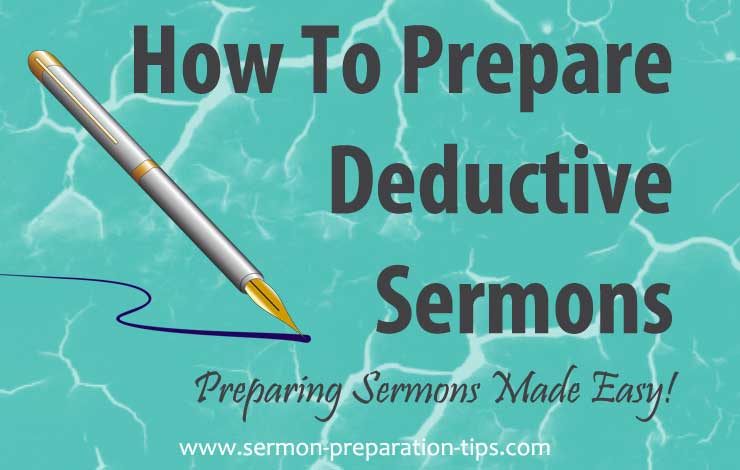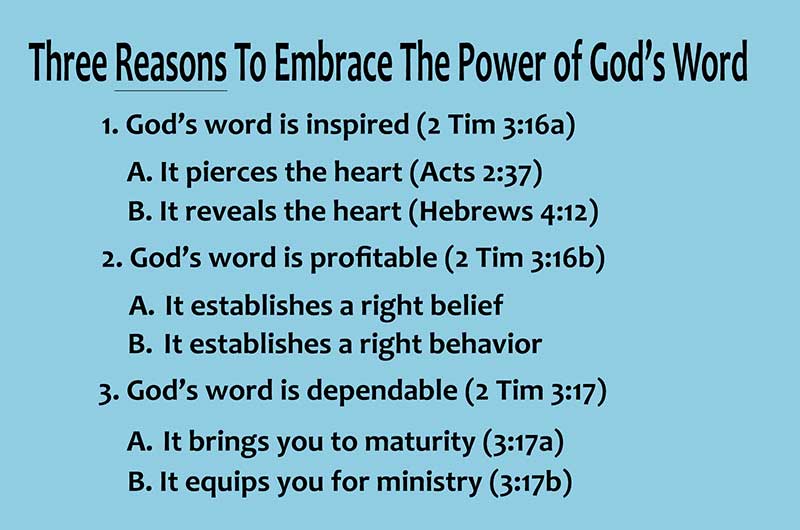How To Prepare A Deductive Sermon: When you need to write two or three sermons a week, it is advantageous to have a set structure for writing sermons. I generally prepare weekly sermons with a deductive model in mind.
Over many years of preaching weekly sermons, I have developed a deductive model of sermon preparation that enables me to prepare two or three weekly sermons with ease. I will share my deductive model with several examples.

How To Prepare A Deductive Sermon
I learned the inductive and deductive models in seminary but it wasn’t until I started preaching on a weekly basis that I found a deductive model that suited my style of preaching.
The deductive model I use breaks the sermon into three parts – the sermon introduction, the sermon body and the sermon conclusion.
The sermon body is the sermon outline. I construct the sermon outline deductively. The sermon outline also has three parts – the main preaching point, sub-points and incidental points and a key word or hinge word.
The best way I can summarise my deductive model is to show you two examples of a deductive sermon outline in order to explain how I put those deductive sermon outlines together.
1. The Two Examples
These two examples come from the book of Ephesians. I usually preach through books of the Bible verse by verse. By doing this, I have outlined most of the New Testament this way.
A DEDUCTIVE SERMON OUTLINE FROM EPHESIANS 5:1-7
Introduction:
There are five godly QUALITIES reflected in our new life in Christ. They are:
1. We walk in godliness (5:1)
2. We walk in love (5:2)
- We seek forgiving love (4:32)
- We seek giving love (5:2b)
- We seek living love (5:2a)
3. We walk in purity (5:3-4a)
- We seek pure behaviour (5:3))
- We seek pure speech (5:4a)
4. We walk in thankfulness (5:4b)
5. We walk in discernment (5:5-7)
- We notice empty promises (5:5)
- We notice empty words (5:6-7)
Conclusion:
A DEDUCTIVE SERMON OUTLINE FROM EPHESIANS 6:14-17
Introduction:
There are six TRUTHS we must consider if we are going to stand firm in the spiritual battles in our Christian walk. They are…
1. We need to live truthfully (6:14a)
- Truthful living begins with preparation
- Truthful living is based in God’s truth
2. We need to live righteously (6:14b)
- Righteous living protects us
- Righteous living is living for God
3. We need to live steadfastly (6:15)
4. We need to live faithfully (6:16)
- Faithful living shelters us
- Faithful living is simply trusting Jesus
5. We need to live confidently (6:17a)
6. We need to live Scripturally (6:17b)
- It is a defensive weapon
- It is an offensive weapon
Conclusion:
[NOTE] The deductive model I have developed breaks the deductive sermon outline in to three parts – the sermon introduction, the sermon body and the sermon conclusion.
[NOTE] The sermon body is the sermon outline which also has three parts – the main preaching point, sub-points and incidental points and a key word or hinge word.
[NOTE] A deductive sermon usually follows a structure whereby the introduction introduces the main preaching point. Once you introduce the main preaching point, the deductive sermon expands and explains the main preaching point with sub-points and incidental points. The deductive sermon concludes with a conclusion.

2. The Deductive Sermon
I always tell my students that a deductive sermon is like an airplane flight. It has a take-off, a flight and a landing. The take-off is the introduction. The flight is the body of the sermon and the conclusion is the landing.
A deductive sermon has an introduction, a body and a conclusion. It is paramount to remember that the body of the sermon is the message you are going to share with your audience. In other words, the bulk of your deductive sermon is the body of the sermon.
The introduction simply introduces your deductive sermon. It should be short and sweat. It should engage your audience in order to deliver the message you want to preach.
The conclusion should conclude the message. Again it should be short and precise. It should summarise your message with a call to action.
The body of the sermon is the sermon outline. I never write a sermon until I have crafted the sermon outline. This one fundamental exercise will help you write weekly sermons with ease. This leads us to the deductive sermon outline.
3. The Deductive Sermon Outline
I haven’t mentioned the work that I do with the text of Scripture before I begin crafting the deductive sermon outline.
Because I preach through books of the Bible verse by verse, I usually diagram the original language or formulate a mechanical layout of the passage of Scripture. This gives me the information I need to craft the sermon outline from the passage of Scripture.
Generally, I would put about five hours in working the passage of Scripture, about one hour crafting the sermon outline and between two or three hours writing content to the sermon outline with illustrations and application and then writing the introduction and conclusion.
A. The Main Preaching Point
Looking back at the sermon outline example from Ephesians 6:14-17, I developed the main preaching point from verse 14. The main preaching point is: standing firm in the spiritual battles in life.
Once I had the main preaching point, I looked for an angle from which I could develop the sub-points. I used the angle of how to stand firm in the spiritual battle of life. Now I developed the sub-points and incidental points.
B. The Sub-Points and Incidental Points
The sub-points simply flowed from the text. We can stand firm in spiritual battles by living truthfully, righteously, steadfastly, faithfully, confidently and Scripturally.
The incidental points simply expand and explain the sub-points. Sub-points don’t always need incidental points to expand and explain the sub-point; however, sometimes it does.
C. The Key Word or Hinge Word
The key word or hinge word simply swings all the sub-points from the main preaching point. This enables the preacher to put all the sub-points under the main preaching point. The key word or hinge word must be a plural noun.
Also this helps the preacher to present the biblical information with cohesion and sequence. In other words, the deductive sermon has a natural flow.
For example: This morning I want to share with you six TRUTHS we must consider if we are going to stand firm in the spiritual battles in life. The first truth is that we need to live truthfully. The second truth is that we need to live righteously. The third truth is that we need to live steadfastly. The fourth truth is that we need to live faithfully. The fifth truth is that we need to live confidently and the sixth truth is that we need to live Scripturally.
With this in mind, you expand and explain one sub-point and then move on to the next sub-point. You may add an illustration or application to each sub-point. By doing this, your audience can easily follow the information as you present the biblical material.
Keep in mind it is not just about delivering the biblical information. It is about engaging the audience so that they can see why the information is important and why they need to apply this biblical information to their Christian lives.
4. The Deductive Sermon Manuscript
As I said before, I never write the sermon until I have crafted the sermon outline. Once I have the deductive sermon outline, it takes very little time to write content to the sermon outline with illustrations and applications.
Once I have written the content, illustrations and applications, I write the introduction and the conclusion.
It takes about six to eight hours for me to write a deductive sermon. Personally, I find a deductive sermon is easier to write than an inductive sermon.
By writing deductive sermon this way, I can usually preach these sermons with minimum notes because I have done all the hard work putting them together.
Let me share a couple more examples of deductive sermon outlines!
A DEDUCTIVE SERMON OUTLINE FROM EPHESIANS 1:1-7
Introduction:
There are three REASONS why we worship a gracious God. They are…
1. God has BLESSED us (1:3a)
- God has blessed us in Christ Jesus (1:3c)
- God has blessed us with every spiritual blessing (1:3b)
2. God has CHOSEN us (1:4a)
- God chose us before creation (1:4b)
- God chose us for a purpose (1:5)
3. God has ACCEPTED us (1:6a)
- We are accepted in Christ Jesus (1:6b)
- We are forgiven in Christ Jesus (1:7)
Conclusion:
A DEDUCTIVE SERMON OUTLINE FROM EPHESIANS 3:14-21
Introduction:
There are three STEPS in learning to realize the importance of prayer. They are:
1. We need to Understand the Reasons for prayer (3:14-15)
- Paul was overwhelmed by God’s grace
- Paul realized the source of all grace
- Paul realized the magnitude of the ministry of grace
2. We need to understand the Requests in prayer (3:16)
- We tend to prioritize self and the physical
- Paul prioritized others and the spiritual
3. We need to understand the Results of prayer (3:17-21)
- We have greater fellowship (3:17a)
- We have greater love (3:17b)
- We have greater comprehension (3:18)
- We have greater knowledge (3:19a)
- We have greater filling (3:19b)
- We have greater power (3:20)
- We have greater praise (3:21)
Conclusion:
5. Concluding Comments
Though I have been preaching weekly sermons for nearly thirty years or so, it still requires considerable time working with the passage of Scripture to discover the biblical information for the sermon.
However, crafting this biblical information into a deductive sermon outline and writing the full sermon manuscript comes very naturally now.
Crafting the sermon outline and writing the manuscript takes very little time these days and also I really enjoy doing this on a weekly basis. I still write between two or three sermons on a weekly basis.